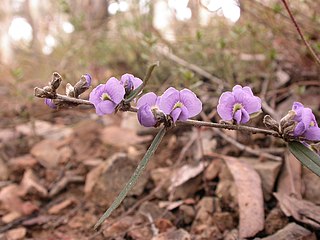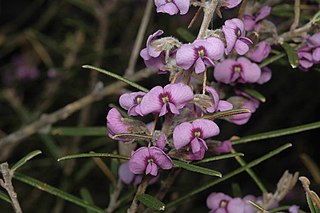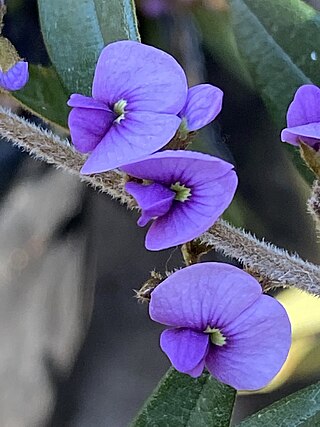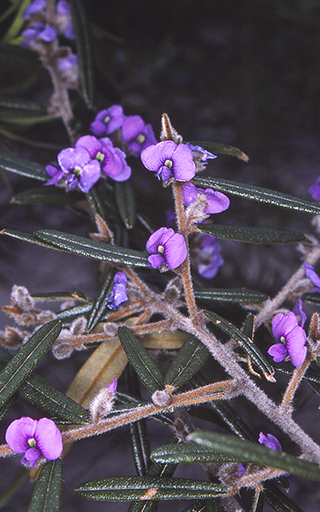
Hovea trisperma, commonly known as common hovea, it is a flowering plant in the family Fabaceae. It is a small straggling shrub with purple-blue flowers and is endemic to Western Australia.

Hovea heterophylla, commonly known as creeping hovea, is a small shrub with linear leaves and purple-violet pea flowers. It is found in all states other than Western Australia.

Hovea pannosa is a species of flowering shrub in the family Fabaceae and is endemic to Australia. It is a small, erect shrub with purple pea flowers and stiff green leaves.

Hovea lanceolata is a flowering plant in the family Fabaceae. It is a small shrub with elliptic leaves and purple pea flowers. It grows in New South Wales and Queensland.

Hovea montana, commonly known as alpine hovea, mountain hovea or alpine rusty-pods, is a flowering plant in the family Fabaceae, and is endemic to Australia. It is a small shrub with narrow leaves and purple pea flowers.

Hovea pungens, commonly known as devil's pins, is a species of flowering plant in the family Fabaceae and is endemic to Western Australia. It is a small, upright shrub with dark green leaves and purple flowers.

Hovea rosmarinifolia, commonly known as mountain beauty or rosemary hovea is a shrub in the family Fabaceae, native to Australia. A small shrub bearing attractive blue-purple or mauve pea flowers from August to November.

Hovea longifolia, commonly known as rusty pods, is a flowering plant in the family Fabaceae, endemic to eastern Australia. It has purple pea flowers, linear leaves with rusty felt like hairs on the lower surface.

Hovea acutifolia, is a species of flowering plant in the family Fabaceae. It is an upright, small shrub with blue to purple pea flowers, dark green leaves and rusty coloured new growth. It grows in Queensland and New South Wales.

Hovea purpurea, commonly known as velvet hovea, is a flowering plant in the family Fabaceae. It is an upright shrub with narrow leaves, purple pea flowers and stems with matted hairs. It grows in New South Wales, Victoria and South Australia.
Hovea corrickiae, is a species of flowering plant in the family Fabaceae and is endemic to south-eastern Australia. It is a shrub or slender tree with densely hairy branchlets, narrowly egg-shaped or elliptic, dark green leaves with stipules at the base, and mostly pale to deep mauve, pea-like flowers.
Hovea cymbiformis is a species of flowering plant in the family Fabaceae and is endemic to New South Wales. It is a shrub with foliage covered with brownish to grey hairs, narrowly elliptic leaves with stipules at the base, and mauve and yellowish-green, pea-like flowers.

Spyridium burragorang, is a flowering shrub in the family Rhamnaceae. It has dense clusters of whitish flowers at the end of branches, alternate leaves and is endemic to New South Wales.
Spyridium coalitum is a species of flowering plant in the family Rhamnaceae and is endemic to Kangaroo Island in South Australia. It is a slender, erect shrub with softly-hairy young stems, oblong to narrowly elliptic leaves, and head of white to cream-coloured flowers.

Hovea pedunculata, is a species of flowering plant in the family Fabaceae. It is a small shrub with mauve flowers, dark green leaves and rusty coloured new growth. It grows in Queensland and New South Wales.

Hovea graniticola is a species of flowering plant in the family Fabaceae and is endemic to eastern Australia. It is a shrub with its branchlets covered with curly brownish to grey hairs, narrowly oblong to almost linear leaves with stipules at the base, and mauve, pea-like flowers.
Hovea magnibractea, is a species of flowering plant in the family Fabaceae and is endemic to south-eastern Australia. It is a shrub with narrowly oblong to lorate (strap-shaped) leaves, and mauve and yellow, pea-like flowers.

Hovea similis is a species of flowering plant in the family Fabaceae and grows in New South Wales and Queensland. It is a shrub or small tree with hairy foliage and mauve and yellowish-green pea-like flowers.

Dampiera ferruginea commonly known as velvet beauty-bush, is a flowering plant in the family Goodeniaceae and is endemic to Queensland. It is a small, upright shrub with blue flowers.
Ricinocarpos trichophorus is a species of flowering plant in the family Euphorbiaceae and is endemic to the south coast of Western Australia. It is an erect, openly branched, monoecious shrub with linear to narrowly oblong leaves, and white flowers in a raceme with two female flowers and up to five male flowers.















